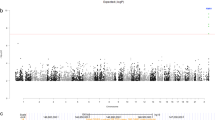Abstract
Between-generation differences in ascertainment were examined in 54 extended fragile X pedigrees, where all available members were clinically, psychometrically, and cytogenetically investigated. In 24 families a diagnosis was verified by molecular characterization using the pfxa3 fragile X-specific probe. We found considerable differences between generations in relative proportions of affected fragile X subjects versus ‘non-penetrant’ carriers. We also found deviation in the segregation ratio in unbiased samples of relatives in pedigrees. We claim that these irregularites are influenced by different rates of ascertainment, depending on the clinical expression of the condition (penetrance) and the fertility of fragile X individuals in a pedigree, as well as by the thoroughness of clinical investigation in individual families. Penetrance and fertilty were estimated in fragile X females assessed by psychometric tests, and they were compared with earlier estimates based on a subjective judgement of their intellectual status. We suggest that the standard correction for ascertainment bias, such as has been applied in segregation analysis of this condition, is not sufficient to adjust for all types of bias.
Similar content being viewed by others
References
Crowe SF, Hay DA (1990) Neuropsychological dimensions of the fragile X syndrome: support for non-dominant hemisphere dys-function hypothesis. Neuropsychologia 28:9–16
D'Amato RC, Gray JW, Dean RS (1988) Construct validity of the PPVT with neuropsychological, intellectual, and achievement measures. J Clin Psychol 44:934–942
Davies KE (1989) The fragile X syndrome. Oxford University Press, Oxford
Dykens EM, Hodapp RM, Leckman J (1987) Strength and weaknesses in the intellectual functioning of males with fragile X syndrome. Am J Ment Defic 92:234–236
Evans JH, Beischer NA (1970) The prognosis of threatened abortion. Med J Aust 25:165–168
Fryns JP (1986) The female and the fragile X: a study of 144 obligate female carriers. Am J Med Genet 23:157–169
Fryns JP (1989) X-linked mental retardation and the fragile X syndrome: a clinical approach. In: Davies KE (ed) The fragile X syndrome. Oxford University Press, Oxford
Fryns JP, Moerman P, Gills F, D'Espallier L, and Van den Berghe H (1988) Suggestively increased rate of infant death in children of fra(X) positive mothers. Am J Med Genet 30:73–75
Fu Y-H, Kuhl DPA, Pizzuti A, Pieretti M, Sutcliffe JS, Richards S, Verkerk AJMH, Holden JJA, Fenwick RG, Warren ST, Oostra BA, Nelson DL, Caskey CT (1991) Variation of CGG repeat at the fragile X site results in genetic instability: resolution of the Sherman paradox. Cell 67:1047–1058
Hagerman RJ (1989) Behaviour and treatment of the fragile X syndrome. In: Davies KE (ed) The fragile X syndrome. Oxford University Press, Oxford
Hagerman RJ, McBogg P (1983) The fragile X syndrome: diagnosis, biochemistry and intervention. Spectra, Dillon, Colo
Kemper MB, Hagerman RJ, Ahmad RS, Mariner R (1986) Cognitive profiles and the spectrum of clinical manifestations in heterozygous Fra(X) females. Am J Med Genet 23:139–156
Kemper MB, Hagerman RJ, Altshul-Stark D (1988) Cognitive profiles of boys with the fragile X syndrome. Am J Med Genet 30:191–200
Laird CD, Jaffe E, Karpen G, Lamb M, Nelson R (1987) Fragile sites in human chromosomes as regions of late-replicating DNA. Trends Genet 3:274–281
Loesch DZ, Hay DA (1988) Clinical features and reproductive patterns in fragile X female heterozygotes. J Med Genet 25:407–414
Loesch DZ, Hay DA, Sutherland GR, Halliday J, Judge C, Webb GC (1987) Phenotypic variation in male-transmitted fragile X: genetic inferences. Am J Med Genet 27:401–417
Loesch DZ, Lafranchi M, Scott D (1988) Anthropometry in Martin-Bell syndrome. Am J Med Genet 30:149–164
Loesch DZ, Hay DA, Leversha M (1991) Male transmission and ascertainment in fragile X. Am J Med Genet 41:410–416
Miezejeski CM, Jenkins EC, Hill AL, Wisniewski K, French JH, Brown WT (1986) A profile of cognitive deficit in females from fragile X families. Neuropsychologia 24:405–409
Morton NE (1982) Outline of genetic epidemiology. Karger, Basel New York
Mulley JC, Yu S, Gedeon AK, Donnelly A, Turner G, Loesch D, Chapman CJ, Gardner RJM, Richards RI, Sutherland GR (1992) Experience with direct molecular diagnosis of fragile X. Am J Med Genet 29:368–374
Sherman SL, Morton NE, Jacobs PA, Turner G, (1984) The marker (X) syndrome: a cytogenetic and genetic analysis. Ann Hum Genet 48:21–37
Sherman SL, Jacobs PA, Morton NE, Froster-Iskenius U, Howard-Peebles PN, Nielsen KB, Partington MW, Sutherland GR, Turner G, Watson M (1985) Further segregation analysis of the fragile X syndrome with special reference to transmitting males. Hum Genet 69:289–299
Sutherland GR, Hecht F (1985) Fragile sites on human chromosomes. Oxford University Press, New York
Sved JA, Laird CD (1990) Population genetic consequences of the fragile-X syndrome, based on the X-inactivation imprinting model. Am J Hum Genet 46:443–451
Theobald TM, Hay DA, Judge C (1987) Individual variation and specific cognitive deficits in the fragile X syndrome. Am J Med Genet 28:1–11
Vogel F, Crusio WE, Kovac C, Fryns JP, Freund M (1990) Selective advantage of fra(X) heterozygotes. Hum Genet 86:25–32
Veenema H, Geraedts JPM, Beverstock GC, Pearson PL, (1987) The fragile X syndrome in a large family. I. Cytogenetic and clinical investigations. J Med Genet 25:23–31
Webb T, Thake A, Todd J (1986) Twelve families with fragile X(q27). J Med Genet 23:400–440
Yu S, Pritchard M, Kremer E, Lynch M, Nancarrow J, Baker E, Holman K, Mulley JC, Warren ST, Schlesinger D, Sutherland GR, Richards RI (1991) Fragile X genotype characterized by an unstable region of DNA. Science 252:1179–1181
Yu S, Mulley J, Loesch DZ, Turner G, Donnelly A, Gedeon A, Hillen D, Kremer E, Lynch M, Pritchard M, Sutherland GR, Richards RI (1992) Fragile X syndrome: unique genetics of the heritable unstable element. Am J Hum Genet 50:968–980
Author information
Authors and Affiliations
Rights and permissions
About this article
Cite this article
Loesch, D.Z., Sheffield, L.J. & Hay, D.A. Between-generation differences in ascertainment and penetrance: relevance to genetic hypotheses in fragile X. Hum Genet 91, 469–474 (1993). https://doi.org/10.1007/BF00217774
Received:
Revised:
Issue Date:
DOI: https://doi.org/10.1007/BF00217774




